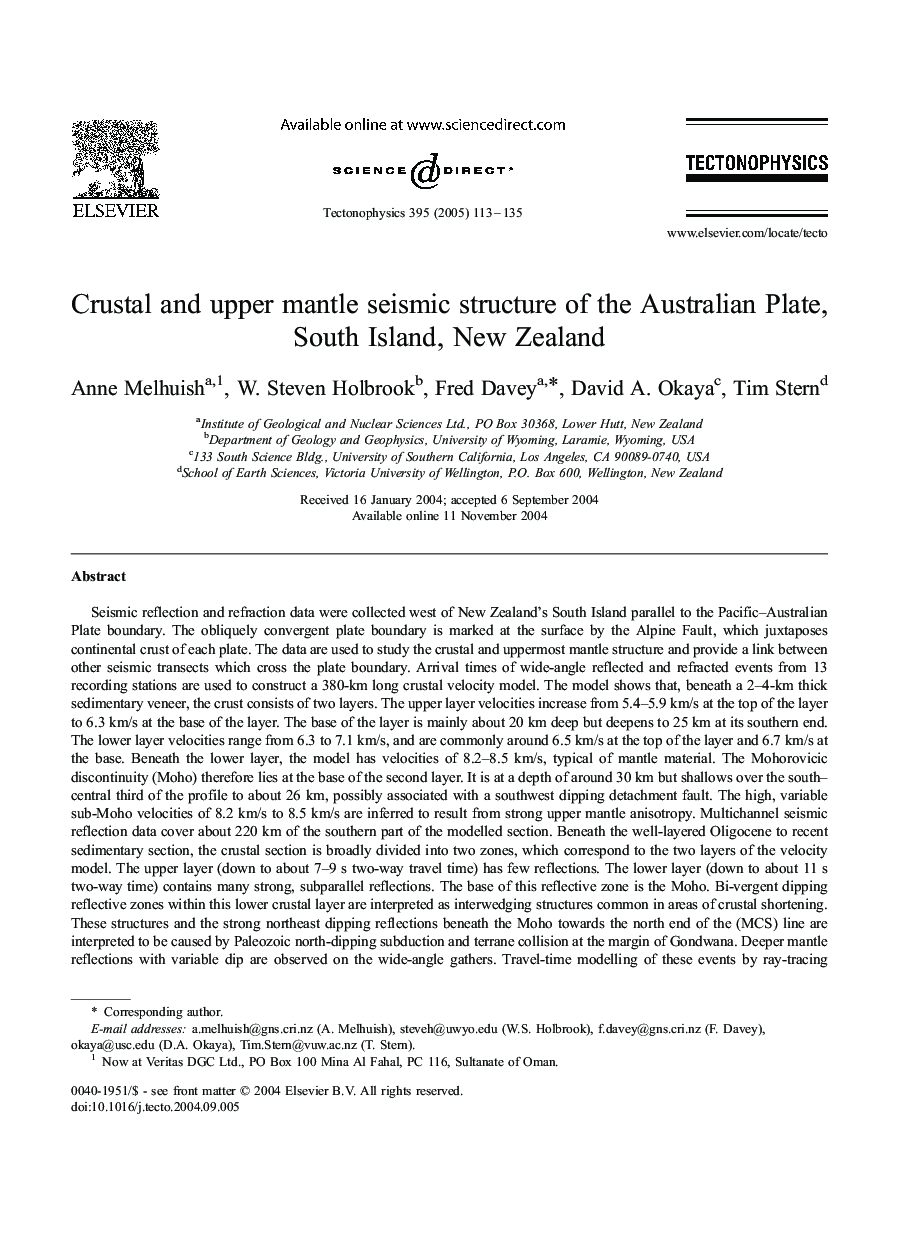| کد مقاله | کد نشریه | سال انتشار | مقاله انگلیسی | نسخه تمام متن |
|---|---|---|---|---|
| 9527179 | 1636991 | 2005 | 23 صفحه PDF | دانلود رایگان |
عنوان انگلیسی مقاله ISI
Crustal and upper mantle seismic structure of the Australian Plate, South Island, New Zealand
دانلود مقاله + سفارش ترجمه
دانلود مقاله ISI انگلیسی
رایگان برای ایرانیان
کلمات کلیدی
موضوعات مرتبط
مهندسی و علوم پایه
علوم زمین و سیارات
فرآیندهای سطح زمین
پیش نمایش صفحه اول مقاله

چکیده انگلیسی
Seismic reflection and refraction data were collected west of New Zealand's South Island parallel to the Pacific-Australian Plate boundary. The obliquely convergent plate boundary is marked at the surface by the Alpine Fault, which juxtaposes continental crust of each plate. The data are used to study the crustal and uppermost mantle structure and provide a link between other seismic transects which cross the plate boundary. Arrival times of wide-angle reflected and refracted events from 13 recording stations are used to construct a 380-km long crustal velocity model. The model shows that, beneath a 2-4-km thick sedimentary veneer, the crust consists of two layers. The upper layer velocities increase from 5.4-5.9 km/s at the top of the layer to 6.3 km/s at the base of the layer. The base of the layer is mainly about 20 km deep but deepens to 25 km at its southern end. The lower layer velocities range from 6.3 to 7.1 km/s, and are commonly around 6.5 km/s at the top of the layer and 6.7 km/s at the base. Beneath the lower layer, the model has velocities of 8.2-8.5 km/s, typical of mantle material. The Mohorovicic discontinuity (Moho) therefore lies at the base of the second layer. It is at a depth of around 30 km but shallows over the south-central third of the profile to about 26 km, possibly associated with a southwest dipping detachment fault. The high, variable sub-Moho velocities of 8.2 km/s to 8.5 km/s are inferred to result from strong upper mantle anisotropy. Multichannel seismic reflection data cover about 220 km of the southern part of the modelled section. Beneath the well-layered Oligocene to recent sedimentary section, the crustal section is broadly divided into two zones, which correspond to the two layers of the velocity model. The upper layer (down to about 7-9 s two-way travel time) has few reflections. The lower layer (down to about 11 s two-way time) contains many strong, subparallel reflections. The base of this reflective zone is the Moho. Bi-vergent dipping reflective zones within this lower crustal layer are interpreted as interwedging structures common in areas of crustal shortening. These structures and the strong northeast dipping reflections beneath the Moho towards the north end of the (MCS) line are interpreted to be caused by Paleozoic north-dipping subduction and terrane collision at the margin of Gondwana. Deeper mantle reflections with variable dip are observed on the wide-angle gathers. Travel-time modelling of these events by ray-tracing through the established velocity model indicates depths of 50-110 km for these events. They show little coherence in dip and may be caused side-swipe from the adjacent crustal root under the Southern Alps or from the upper mantle density anomalies inferred from teleseismic data under the crustal root.
ناشر
Database: Elsevier - ScienceDirect (ساینس دایرکت)
Journal: Tectonophysics - Volume 395, Issues 1â2, 6 January 2005, Pages 113-135
Journal: Tectonophysics - Volume 395, Issues 1â2, 6 January 2005, Pages 113-135
نویسندگان
Anne Melhuish, W. Steven Holbrook, Fred Davey, David A. Okaya, Tim Stern,